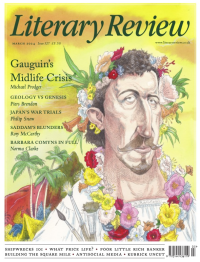Lucy Lethbridge
Tear Off Those Corsets
Trailblazer: Barbara Leigh Smith Bodichon – The First Feminist to Change Our World
By Jane Robinson
Doubleday 397pp £25
Social historian Jane Robinson is a champion of the hard, unglamorous work of campaigning women. In Hearts and Minds, she drew a vividly exciting picture of the petitions, marches, oratory, passion and steady perseverance that won women the vote. Less interested in the flashy antics of the suffragettes, who have tended to hog the historical limelight, she concentrated on the non-violent persistence of the suffragists. Her books paint a picture of gaslit church halls, committees and subcommittees, and comradely leaflet-printing, poster-gumming, typewriter-pounding and proofreading. Through skilful storytelling and a warm-hearted narrative style, she makes endeavour, high-mindedness and idealism seem both compelling and, in its deep and intellectual friendships, even romantic.
Barbara Bodichon was a suffragist, a bluestocking (one of the founders of Girton College, Cambridge) and a campaigner for women’s rights and girls’ education. She could be found in dissenting (she was brought up a Unitarian) and radical circles. She knew everyone: she was a great friend of George Eliot (of whom she drew a marvellous sketch) and the first cousin of Florence Nightingale, and she belonged to a sisterhood of writers, organisers and doers (the book contains a fascinating chart of all her connections). She arranged the first mass petition to Parliament for women’s suffrage and led the committee that helped bring about the Married Women’s Property Act of 1882. Many of the rights we take for granted today can be traced back to Bodichon and her friends.
It’s no wonder that Robinson thought she would make a good subject for a biography. But organisational skill doesn’t always mean a character leaps off the page. What makes Bodichon’s life alluring to the modern reader is the riotous unconventionality of her own family. Born illegitimate in 1827, she was the eldest of the five children of Benjamin Smith, a wealthy man who appears to have had an aversion to marriage, and Anne Longden, the milliner daughter of a miller. Smith maintained his family in comfortable style in a ‘picture-book cottage’ near his own large house in Sussex. This was not dissimilar to many a Victorian set-up, in which an unsuitable mistress might be kept on the side. Except that Smith wasn’t the type of man this scenario would suggest. He was quite open about his domestic arrangements. A radical from a Unitarian family of campaigning abolitionists who had made a fortune in the grocery trade, he was a believer in girls’ education, encouraging his children to roam freely over the countryside and to argue, debate and think. Known always to his children as ‘the Pater’, Smith also funded various charitable schools and was interested in Swedenborgian ideas about child rearing.
Robinson is very taken with the Pater. One of the many engaging features of her book is the affection in which she holds her characters. So she finds it hard – as, I think, will readers – to reconcile a figure so boldly outspoken on the subject of women’s emancipation

Sign Up to our newsletter
Receive free articles, highlights from the archive, news, details of prizes, and much more.@Lit_Review
Follow Literary Review on Twitter
Twitter Feed
Margaret Atwood has become a cultural weathervane, blamed for predicting dystopia and celebrated for resisting it. Yet her ‘memoir of sorts’ reveals a more complicated, playful figure.
@sophieolive introduces us to a young Peggy.
Sophie Oliver - Ms Fixit’s Characteristics
Sophie Oliver: Ms Fixit’s Characteristics - Book of Lives: A Memoir of Sorts by Margaret Atwood
literaryreview.co.uk
For a writer so ubiquitous, George Orwell remains curiously elusive. His voice is lost, his image scarce; all that survives is the prose, and the interpretations built upon it.
@Dorianlynskey wonders what is to be done.
Dorian Lynskey - Doublethink & Doubt
Dorian Lynskey: Doublethink & Doubt - Orwell: 2+2=5 by Raoul Peck (dir); George Orwell: Life and Legacy by Robert Colls
literaryreview.co.uk
The court of Henry VIII is easy to envision thanks to Hans Holbein the Younger’s portraits: the bearded king, Anne of Cleves in red and gold, Thomas Cromwell demure in black.
Peter Marshall paints a picture of the artist himself.
Peter Marshall - Varnish & Virtue
Peter Marshall: Varnish & Virtue - Holbein: Renaissance Master by Elizabeth Goldring
literaryreview.co.uk